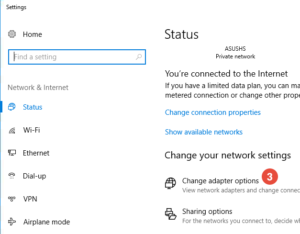
- Disable ipv6 loopback windows 10 update#
- Disable ipv6 loopback windows 10 Pc#
- Disable ipv6 loopback windows 10 windows 8#
This makes everything faster because there is no handling of checksum. IPv6 moves the handling of fragmentation to the device rather than the router.
Disable ipv6 loopback windows 10 Pc#
VOIP QoS is more robust because direct connections to the PC are possible. We no longer have to try to keep those two networks separate through IP addressing. Every computer can have an address that allows it to get to the Internet using the same IP that allows it access to internal resources. Here are a few of the advantages of IPv6. My, how things have changed! In IPv6 security is its top priority. In fact, there is no security built into IPv4.

When it was built, the population of computers were a lot smaller and there was no real need for security. IPv4 is one of the longest-lived pieces of technology in our computers today.
Disable ipv6 loopback windows 10 windows 8#
But starting with Windows 8 and Server 2012, Windows detects that there is no route to the Internet in IPv6, remembers this, and then prefers IPv4 for this type of traffic. Back in the Windows 7 days there was a condition where there would be a lag getting to the Internet when IPv6 was enabled and your router didn’t support it. That waiting to fail can really be felt on the PC when you disable IPv6. Of course, many things do but behind the scenes, Windows has to work hard and fall back to older protocols after it finds that IPv6 isn’t available. IPv6 is core to the Windows operating system and Microsoft doesn’t do any testing with it turned off so they won’t guarantee that anything will work properly without IPv6. But let Windows prefer IPv6 for the reasons I’m going to discuss now. You can use IPv4 for the ease of readability. But that still doesn’t mean that you want to disable IPv6. Your internal DHCP can still use IPv4 for compatibility reasons but you’ll end up using IPv6 to access the Internet. I’m not going to bother to rehash that here other than to say that this doesn’t matter for your internal network. We all know that the world is running out of IPv4 addresses. Now that we’ve gotten that out of the way, let’s take a look at how Windows uses IPv6 even when your DHCP server is providing it an IPv4 address and your Internet router doesn’t support it. Max Value: 0xFF (IPv6 disabled) IPv6 Functionality Location: HKEY_LOCAL_MACHINE\SYSTEM\CurrentControlSet\Services\Tcpip6\Parameters\ To configure IPv6, modify the following registry value based on the this table.


(Meanwhile, for those who want to transition from IPv4 to IPv6, check out this story.) But before we get to that, if you just can’t stomach it or you have some serious legacy applications or hardware, here is Microsoft’s official recommendation: Keep IPv6 enabled but issue a policy that says to prefer IPv4. I’m going to argue that in most cases it is not necessary or desirable to disable IPv6 and, in fact, it is desirable not to. Since so many people are disabling IPv6, many readers are probably already jaded at the prospect of allowing IPv6 on their network. Should you be doing that? Probably not.īut first things first.
Disable ipv6 loopback windows 10 update#
A recent Windows 10 update brought to light just how many people are disabling IPv6 as part of their normal process.


 0 kommentar(er)
0 kommentar(er)
